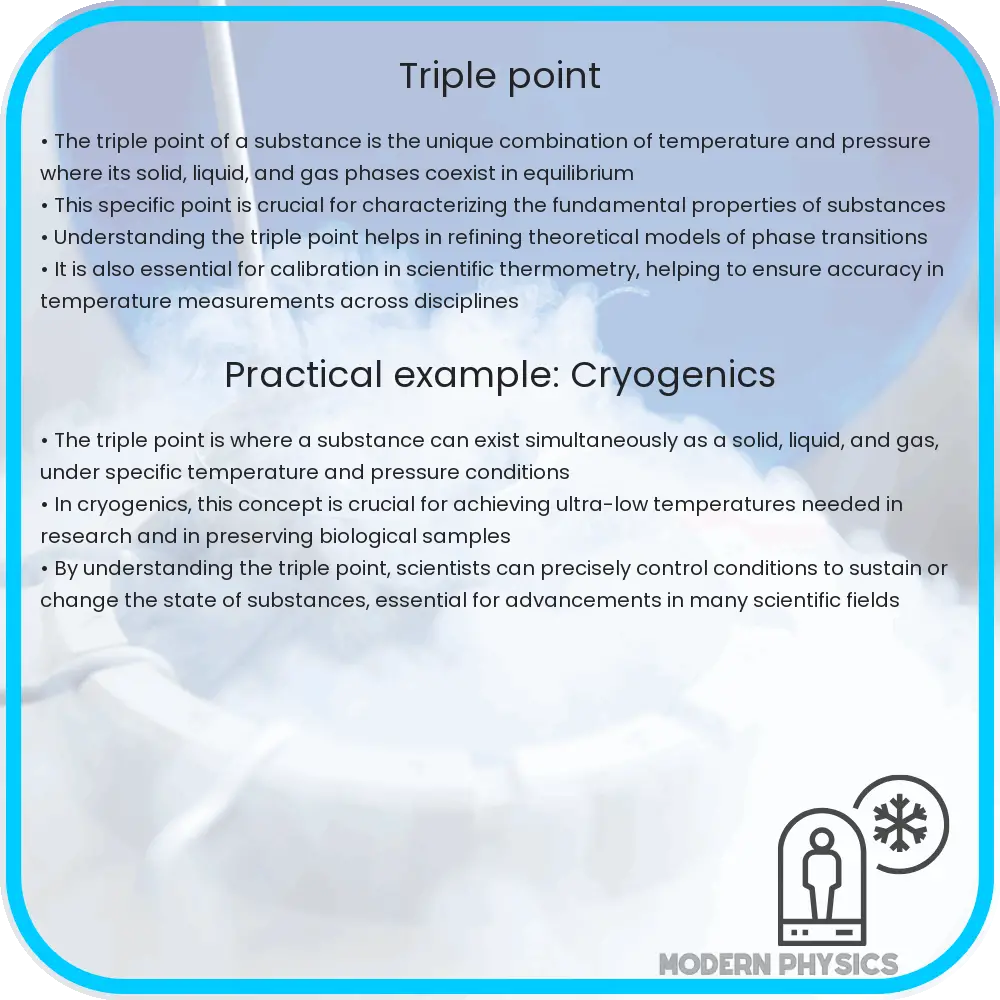Explore the intriguing concept of the Triple Point in phase transitions, its significance, applications, and impact on scientific research.

Understanding the Triple Point in Phase Transitions
The concept of the Triple Point is a fascinating phenomenon in the realm of physical chemistry, representing a unique set of conditions where three phases of a substance coexist in thermodynamic equilibrium. This concept is crucial in understanding phase transitions and the behavior of substances under different temperature and pressure conditions.
What is a Triple Point?
The triple point of a substance is the specific temperature and pressure at which its solid, liquid, and gas phases coexist in equilibrium. This point is unique to each substance and is a critical aspect of its phase diagram, which is a graphical representation of the conditions under which distinct phases occur and coexist.
Phase Transition and Equilibrium
In a phase transition, a substance changes from one state of matter (solid, liquid, or gas) to another. These transitions occur due to changes in environmental conditions like temperature and pressure. For example, when ice (solid water) melts, it transitions to liquid water. The triple point is the condition under which all three phases can transition into each other without energy loss, maintaining equilibrium.
Significance of Pressure in Triple Points
Pressure plays a pivotal role in the existence and stability of the triple point. At the triple point, even a slight variation in pressure can cause a shift in the phase equilibrium. This sensitivity makes the triple point a valuable tool in calibrating thermodynamic instruments, such as thermometers and barometers.
Examples in Nature
One of the most well-known examples of a triple point is that of water (H2O). The triple point of water occurs at approximately 0.01°C (273.16K) and 0.00604 atmospheres of pressure. This unique point is used to define the Kelvin, the base unit of temperature in the International System of Units (SI).
Understanding the triple point and its implications is not only essential for scientific research but also has practical applications in various industries, including meteorology, materials science, and engineering. The concept helps in predicting the behavior of materials under different environmental conditions and in the design of systems that need to operate efficiently across various phases.
Applications of Triple Point Knowledge
The understanding of triple points has significant applications in various fields. In meteorology, it assists in predicting weather patterns and atmospheric behavior by understanding the phase changes of water in the atmosphere. In materials science, knowledge of the triple point helps in designing substances that can withstand extreme conditions, making it crucial for aerospace and deep-sea applications.
Experimental Observation of Triple Points
Observing the triple point in a laboratory setting requires precise control of temperature and pressure. Specially designed apparatuses allow scientists to recreate the conditions of a substance’s triple point, enabling the study of phase transitions and the properties of materials at these unique conditions. This experimentation has led to advancements in our understanding of thermodynamics and material properties.
Triple Point in Other Substances
While water’s triple point is the most commonly referenced, other substances also have their unique triple points. For instance, carbon dioxide’s triple point occurs at about -56.6°C and 5.11 atmospheres, where it can exist as a solid, liquid, and gas simultaneously. These varying triple points offer insights into the diverse behaviors of substances under different conditions.
Challenges and Future Research
One of the challenges in studying triple points is the need for high precision in measuring instruments. Future research in this area may focus on developing more accurate and sensitive devices that can detect minor changes in temperature and pressure. Additionally, exploring the triple points of complex mixtures and compounds can open new avenues in understanding chemical and physical processes.
Conclusion
The concept of the triple point in phase transitions plays a crucial role in our understanding of thermodynamics and material science. It exemplifies the delicate balance of temperature and pressure conditions required for the coexistence of different phases of a substance. The study of triple points extends beyond academic interest, finding practical applications in various industries and contributing to advancements in technology and science. As research continues, the insights gained from understanding triple points will undoubtedly lead to further innovations and deeper comprehension of the natural world.
